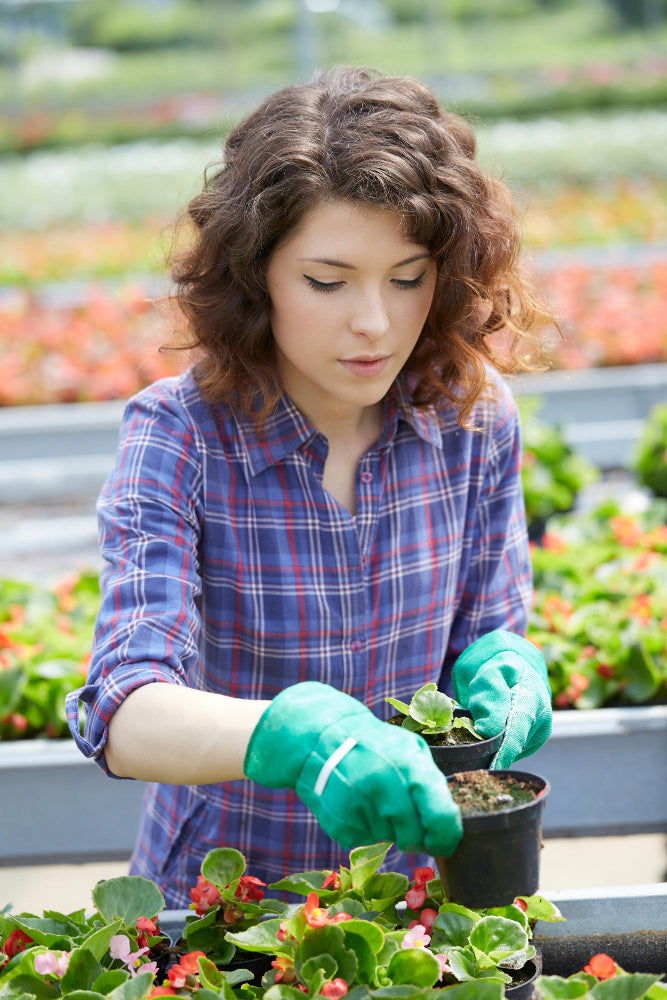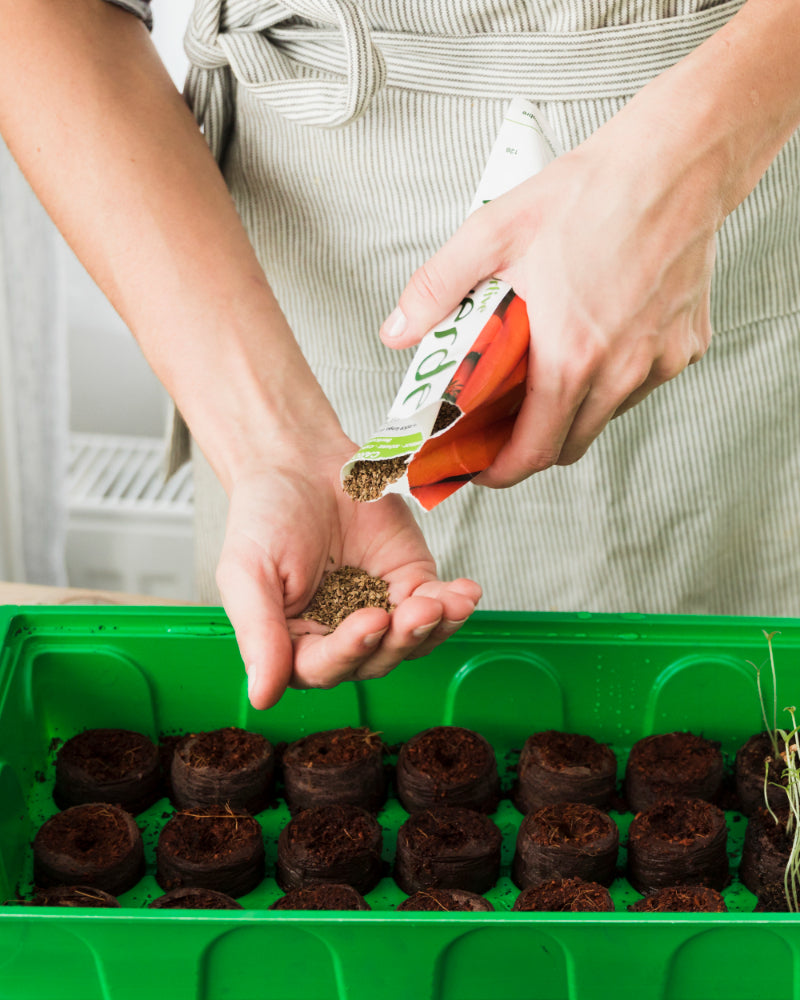When deciding when to sow vegetables in your garden, soil preparation plays a key role - it is the foundation for healthy plant growth and development.
It is important to remember to remove weeds, appropriate soil structure, adjust the pH level and use fertilizers, which gives you the power of resources such as tomatoes, zucchini or potatoes straight from your own land.
Our article will guide you through best practices and tips on choosing the best time to sow vegetables.
When to start sowing vegetables?

When wondering when to sow vegetables , it is worth remembering that different species have different requirements as to the sowing date, which directly affects their growth and yields. Here is some key information to help you plan your sowing:
- Frost-sensitive vegetables, such as beans, are best sown after May 15.
- Vegetables that need more space, such as cucumbers, can be planted directly outdoors in May.
- Peas, tolerant of cold, can be sown in early spring.
Vegetables requiring an earlier start:
- Tomatoes and peppers: Start by sowing seeds indoors in February or March, then transplant outdoors after the last frost.
- Cold-loving vegetables such as broccoli, cauliflower, cabbage, and Brussels sprouts can be sown in late winter or early spring in warmer regions.
Optimal sowing dates for selected vegetables:
- March: spinach, arugula, lettuce, cauliflower
- April: carrots, parsley, dill, celery, onion
- May: tomatoes, peppers, beans, cucumbers
Be sure to check the information on the seed package regarding the best sowing time. Adapt your sowing plan to local weather conditions and the type of vegetables you grow.
Some vegetables are sown directly into the ground, others require prior preparation of seedlings. Grouping vegetables with similar requirements will make their cultivation easier and increase the chances of abundant harvests.
Do you want to start sowing vegetables? Our advice
Sowing vegetables in the garden requires not only appropriate knowledge, but also careful planning. Here are some practical tips to get started:
-
Soil preparation : We start by removing weeds, stones and other waste. Then, the soil should be loosened and enriched by adding compost or well-processed manure. It is important that the soil is loose, fertile and has the right pH level. For most vegetables, the optimal range is 6.00-7.00. If the soil is too acidic, it is worth using lime, and if the soil is too alkaline, use sulfur.
-
Deployment planning :
- Plant arrangement : Some vegetables, such as radishes or lettuce, can be sown directly into the ground, while others, such as tomatoes or cucumbers, require prior preparation of seedlings.
- Planting system : You can choose between traditional rows, raised beds or even a combination of growing vegetables and ornamental plants. Raised beds are convenient and effective, especially when soil quality is poor.
- Crop rotation : Helps prevent diseases and pests. When planning the arrangement, it is worth keeping in mind which plants go well together and which may negatively affect each other.
-
Rules of sowing and care :
- Sowing : Follow the instructions on the seed package. Some seeds, such as carrots or radishes, are sown directly into the ground, others, such as tomatoes, require prior preparation of the seedlings.
- Watering and fertilizing : Regular watering and the use of natural fertilizers such as compost are crucial for healthy plant growth. Mulching can help retain moisture and reduce weed growth.
- Pest control : Natural pest control methods, such as planting garlic among your plants, can help protect your vegetable garden without the use of chemical pesticides.
Remember that success in growing vegetables begins with patience and observation. Each season brings new lessons, and the joy of growing vegetables yourself is incomparable.
What vegetables are worth growing in the garden?

Choosing vegetables to plant in your garden or balcony is as exciting as it is important. Here are some suggestions that will work for both beginners and more experienced gardeners:
-
For beginners:
- Radishes, lettuce, carrots, beans, beets, potatoes - these vegetables are easy to grow and do not require specialized knowledge.
- Śremski Nowy F1 Ground Cucumber, Złota Saxa Bean, or Retro Raspberry Tomato are specific varieties worth considering.
-
For advanced:
- After gaining experience, it is worth trying to grow more exotic plants such as cucumbers, melons or kohlrabi.
- Nightshade vegetables such as tomatoes, peppers and potatoes grow well in larger containers, which is ideal for the balcony.
-
Vegetables for vertical cultivation and on the balcony:
- Tomatoes, peas, cucumbers can be planted together, saving space thanks to vertical growth.
- Vegetables grown in containers, such as lettuce, tomatoes, peppers, cucumbers and herbs, will work great on the balcony.
- Popular choices for the balcony also include climbing beans, celery, parsley, kale, and dill.
Remember that choosing the right varieties and their arrangement can significantly affect the success of your crop. Vegetables that grow well in containers, such as tomatoes, peppers and cucumbers, are ideal for balcony gardens. For those who have a garden, it is worth considering growing vegetables that can be planted together, such as root vegetables (carrots, beets, radishes) or plants with vertical growth (tomatoes, peas, cucumbers), which will allow for maximum use of the available space.
The most important rules when sowing vegetables
When growing vegetables in the garden or on the balcony, it is crucial to follow the rules that will help you obtain rich harvests and healthy plants. Here are the most important ones:
-
Principle of plant neighborhood :
- Some vegetables, such as tomatoes and basil, support each other perfectly, improving growth and repelling pests.
- Avoid planting vegetables from the same family together, such as tomatoes and potatoes, to reduce the risk of disease.
-
Crop rotation :
- Change where you grow vegetables every year to maintain healthy soil and avoid the accumulation of pests and pathogens.
-
Selection of containers and soil :
- Use containers with drainage holes to prevent water from pooling.
- Choose high-quality container growing soil that is rich in organic matter and provides good drainage.
By keeping these rules in mind, you will easily create conditions conducive to the healthy growth of vegetables, both in the garden and on the balcony. Regular monitoring of plants will allow you to react quickly in the event of pests or diseases, and proper fertilization and watering are crucial for abundant harvests.
Can vegetables be grown in pots on the balcony?
Growing vegetables on the balcony is not only the opportunity to enjoy fresh, home-grown crops, but also a chance to create a green oasis that brings many benefits. For children, it can be a fascinating live biology lesson, teaching them about the life cycles of plants, the importance of regular watering and taking care of green plants. Seniors and people with limited mobility can find a source of relaxation and therapy in the balcony garden, enjoying the daily care of plants. Moreover, when growing vegetables at home, you have full control over what substances are used to grow them, which is especially important for people who care about a healthy lifestyle.
- Education for children : Growing vegetables on the balcony is a great way to practice biology lessons. Children learn how plants grow from seeds, what is needed for their proper development and the importance of regular care.
- Recreation for seniors : For older people, a balcony garden can be a source of everyday joy and an opportunity to engage in outdoor activities, even without leaving home.
- Control over cultivation : When you decide to grow vegetables at home, you can be sure that the products on your plate are free from unwanted chemicals.
Additionally, grouping vegetables with herbs not only optimizes space, but also supports plant growth and repels pests. Growing vegetables on the balcony is not only a step towards self-sufficiency, but also a way to a healthier diet and greater closeness to nature, even in the urban jungle.
Your own grocery store nearby!
Creating your own vegetable garden doesn't have to be complicated. Here are some steps to help you achieve this goal:
-
Choice of venue :
- Make sure the location you choose is well sunny. Most vegetables need at least 6 hours of sunlight per day.
- Check that the soil is fertile and well-draining. If not, consider adding compost or creating raised beds.
-
Cultivation planning :
- Decide which vegetables you want to grow. Remember to rotate crops to prevent soil degradation and pest accumulation.
- Consider growing plants that complement each other well, such as tomato and basil. This not only saves space but also helps keep pests away.
-
Care :
- Regular watering is key, especially on warm days. Use water sparingly, preferably in the morning or evening, to minimize evaporation.
- Monitor plants for pests and diseases. Use natural methods to combat them, e.g. by introducing beneficial insects.
Remember that each vegetable has its own specific requirements for sowing, growth and harvesting. Careful planning and attention to detail will allow you to enjoy abundant harvests straight from your garden.

